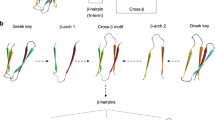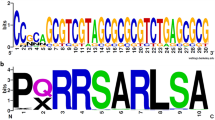Abstract
Nanobodies (VHHs) are engineered fragments of the camelid single-chain immunoglobulins. The VHH domain contains the highly variable segments responsible for antigen recognition. VHHs can be easily produced as recombinant proteins. Their small size is a good advantage for in silico approaches. Computer methods represent a valuable strategy for the optimization and improvement of their binding affinity. They also allow for epitope selection offering the possibility to design new VHHs for regions of a target protein that are not naturally immunogenic. Here we present an in silico mutagenic protocol developed to improve the binding affinity of nanobodies together with the first step of their in vitro production. The method, already proven successful in improving the low Kd of a nanobody hit obtained by panning, can be employed for the ex novo design of antibody fragments against selected protein target epitopes.
Access this chapter
Tax calculation will be finalised at checkout
Purchases are for personal use only
Similar content being viewed by others
References
Melarkode Vattekatte A, Shinada NK, Narwani TJ et al (2020) Discrete analysis of camelid variable domains: sequences, structures, and in-silico structure prediction. PeerJ 8:e8408. https://doi.org/10.7717/peerj.8408
Mitchell LS, Colwell LJ (2018) Comparative analysis of nanobody sequence and structure data. Proteins Struct Funct Bioinforma 86:697–706. https://doi.org/10.1002/prot.25497
Zavrtanik U, Lukan J, Loris R et al (2018) Structural basis of epitope recognition by heavy-chain camelid antibodies. J Mol Biol 430:4369–4386. https://doi.org/10.1016/j.jmb.2018.09.002
Arbabi-Ghahroudi M (2017) Camelid single-domain antibodies: historical perspective and future outlook. Front Immunol 8:1–8. https://doi.org/10.3389/fimmu.2017.01589
Wang Y, Fan Z, Shao L et al (2016) Nanobody-derived nanobiotechnology tool kits for diverse biomedical and biotechnology applications. Int J Nanomedicine 11:3287–3303. https://doi.org/10.2147/IJN.S107194
De Vlieger D, Ballegeer M, Rossey I et al (2018) Single-domain antibodies and their formatting to combat viral infections. Antibodies 8:1. https://doi.org/10.3390/antib8010001
Soler MA, Fortuna S, De Marco A, Laio A (2018) Binding affinity prediction of nanobody-protein complexes by scoring of molecular dynamics trajectories. Phys Chem Chem Phys 20:3438–3444. https://doi.org/10.1039/c7cp08116b
Kuroda D, Tsumoto K (2020) Engineering stability, viscosity, and immunogenicity of antibodies by computational design. J Pharm Sci 109:1631–1651. https://doi.org/10.1016/j.xphs.2020.01.011
Guilliams T, El-Turk F, Buell AK et al (2013) Nanobodies raised against monomeric α-synuclein distinguish between fibrils at different maturation stages. J Mol Biol 425:2397–2411. https://doi.org/10.1016/j.jmb.2013.01.040
Cheng X, Wang J, Kang G et al (2019) Homology modeling-based in silico affinity maturation improves the affinity of a nanobody. Int J Mol Sci 20(17):4187
Soler MA, Medagli B, Semrau MS et al (2019) A consensus protocol for the: in silico optimisation of antibody fragments. Chem Commun 55:14043–14046. https://doi.org/10.1039/c9cc06182g
Gladich I, Rodriguez A, Hong Enriquez RP et al (2015) Designing high-affinity peptides for organic molecules by explicit solvent molecular dynamics. J Phys Chem B 119:12963–12969. https://doi.org/10.1021/acs.jpcb.5b06227
Hong Enriquez RP, Pavan S, Benedetti F et al (2012) Designing short peptides with high affinity for organic molecules: a combined docking, molecular dynamics, and Monte Carlo approach. J Chem Theory Comput 8:1121–1128. https://doi.org/10.1021/ct200873y
Del Carlo M, Capoferri D, Gladich I et al (2016) In silico design of short peptides as sensing elements for phenolic compounds. ACS Sensors 1:279–286. https://doi.org/10.1021/acssensors.5b00225
Guida F, Battisti A, Gladich I et al (2018) Peptide biosensors for anticancer drugs: design in silico to work in denaturizing environment. Biosens Bioelectron 100:298–303. https://doi.org/10.1016/j.bios.2017.09.012
Soler MA, Rodriguez A, Russo A et al (2017) Computational design of cyclic peptides for the customized oriented immobilization of globular proteins. Phys Chem Chem Phys 19:2740–2748. https://doi.org/10.1039/c6cp07807a
Russo A, Scognamiglio PL, Enriquez RPH et al (2015) In silico generation of peptides by replica exchange monte carlo: docking-based optimization of maltose-binding-protein ligands. PLoS One 10:1–16. https://doi.org/10.1371/journal.pone.0133571
Soler MA, Fortuna S, Scoles G (2015) Computational design of peptides as probes for the recognition of protein biomarkers. Eur Biophys J WITH Biophys Lett 44:S149
Ochoa R, Soler MA, Laio A, Cossio P (2020) PARCE: protocol for amino acid refinement through computational evolution. Comput Phys Commun 260:107716
Pronk S, Páll S, Schulz R et al (2013) GROMACS 4.5: a high-throughput and highly parallel open source molecular simulation toolkit. Bioinformatics 29:845–854. https://doi.org/10.1093/bioinformatics/btt055
Krivov GG, Shapovalov MV, Dunbrack RL Jr (2009) Improved prediction of protein side-chain conformations with SCWRL4. Proteins 77:778–795. https://doi.org/10.1002/prot.22488
Vreven T, Hwang H, Weng Z (2011) Integrating atom-based and residue-based scoring functions for protein-protein docking. Protein Sci 20:1576–1586. https://doi.org/10.1002/pro.687
Andrusier N, Nussinov R, Wolfson HJ (2007) FireDock: fast interaction refinement in molecular docking. Proteins Struct Funct Bioinforma 69:139–159. https://doi.org/10.1002/prot.21495
Sarti E, Granata D, Seno F et al (2015) Native fold and docking pose discrimination by the same residue-based scoring function. Proteins Struct Funct Bioinforma 83(4):621–630. https://doi.org/10.1002/prot.24764
Dominguez C, Boelens R, Bonvin AMJJ (2003) HADDOCK: a protein−protein docking approach based on biochemical or biophysical information. J Am Chem Soc 125:1731–1737. https://doi.org/10.1021/ja026939x
Fogolari F, Corazza A, Yarra V et al (2012) Bluues: a program for the analysis of the electrostatic properties of proteins based on generalized Born radii. BMC Bioinformatics 13:1–16. https://doi.org/10.1186/1471-2105-13-S4-S18
Veggiani G, Giabbai B, Semrau MS et al (2020) Comparative analysis of fusion tags used to functionalize recombinant antibodies. Protein Expr Purif 166:105505. https://doi.org/10.1016/j.pep.2019.105505
Fisher RD, Ultsch M, Lingel A et al (2010) Structure of the complex between HER2 and an antibody paratope formed by side chains from tryptophan and serine. J Mol Biol 402:217–229. https://doi.org/10.1016/j.jmb.2010.07.027
Guex N, Peitsch MC (1997) SWISS-MODEL and the Swiss-PdbViewer: an environment for comparative protein modeling. Electrophoresis 18:2714–2723. https://doi.org/10.1002/elps.1150181505
Van Zundert GCP, Rodrigues JPGLM, Trellet M et al (2016) The HADDOCK2.2 web server: user-friendly integrative modeling of biomolecular complexes. J Mol Biol 428:720–725. https://doi.org/10.1016/j.jmb.2015.09.014
Cho H-S, Mason K, Ramyar KX et al (2003) Structure of the extracellular region of HER2 alone and in complex with the Herceptin Fab. Nature 421:756–760. https://doi.org/10.1038/nature01392
Soler MA, De Marco A, Fortuna S (2016) Molecular dynamics simulations and docking enable to explore the biophysical factors controlling the yields of engineered nanobodies. Sci Rep 6:1–11. https://doi.org/10.1038/srep34869
Daura X, Gademann K, Jaun B et al (1999) Peptide folding: when simulation meets experiment. Angew Chem Int Ed 38:236–240. https://doi.org/10.1002/(sici)1521-3773(19990115)38:1/2<236::aid-anie236>3.3.co;2-d
Scarabelli G, Morra G, Colombo G (2010) Predicting interaction sites from the energetics of isolated proteins: a new approach to epitope map**. Biophys J 98:1966–1975. https://doi.org/10.1016/j.bpj.2010.01.014
Stothard P (2000) The sequence manipulation suite: JavaScript programs for analyzing and formatting protein and DNA sequences. BioTechniques 28(1102):1104. https://doi.org/10.2144/00286ir01
Acknowledgments
This work has been funded by the Italian Association for Cancer Research (AIRC) through the grant “My First AIRC grant” Rif.18510 (PI: Fortuna) and the CINECA Awards N. HP10C70TG1, 2018, for the availability of high performance computing resources and support.
Author information
Authors and Affiliations
Corresponding authors
Editor information
Editors and Affiliations
Rights and permissions
Copyright information
© 2023 Springer Science+Business Media, LLC, part of Springer Nature
About this protocol
Cite this protocol
Medagli, B., Soler, M.A., De Zorzi, R., Fortuna, S. (2023). Antibody Affinity Maturation Using Computational Methods: From an Initial Hit to Small-Scale Expression of Optimized Binders. In: Tsumoto, K., Kuroda, D. (eds) Computer-Aided Antibody Design. Methods in Molecular Biology, vol 2552. Humana, New York, NY. https://doi.org/10.1007/978-1-0716-2609-2_19
Download citation
DOI: https://doi.org/10.1007/978-1-0716-2609-2_19
Published:
Publisher Name: Humana, New York, NY
Print ISBN: 978-1-0716-2608-5
Online ISBN: 978-1-0716-2609-2
eBook Packages: Springer Protocols




